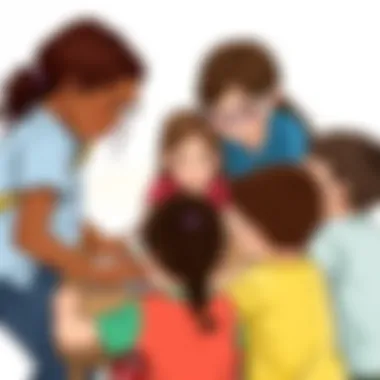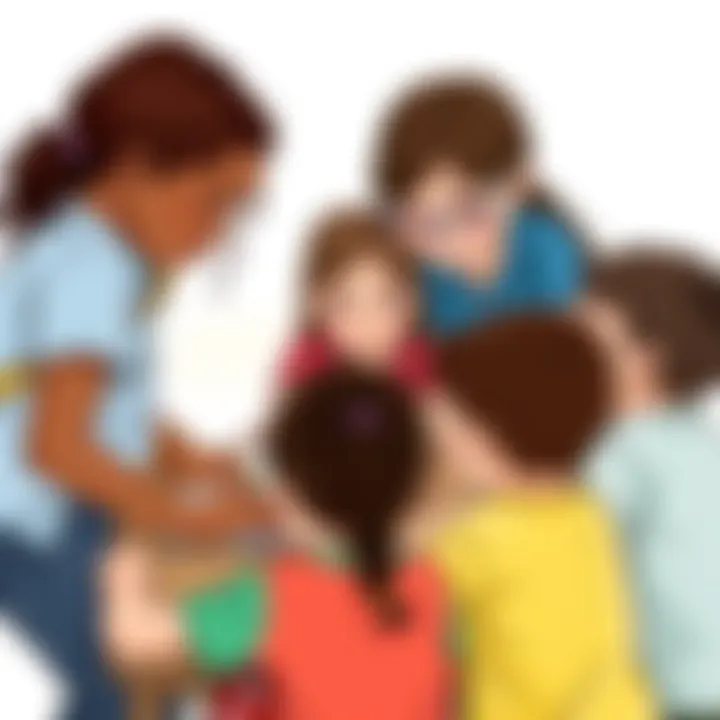Engaging Team Building Activities for Young Learners


Intro
Creating a spirit of collaboration in educational settings for young learners can be both an art and a science. Children, especially those aged three to twelve, are at a pivotal stage of learning where their social and cognitive skills are rapidly developing. This is the prime time to introduce them to team-building activities that not only facilitate effective learning but also foster love for cooperation among peers.
The objective here is quite simple: engage kids in activities that teach them the importance of working together while enriching their educational journey. Cooperative games, imaginative DIY projects, and creative crafts can act as powerful tools to instill essential life skills in children. What follows is a detailed breakdown of various engaging activities aimed at promoting teamwork, enhancing cognitive abilities, and encouraging interpersonal relations.
Interactive Learning Games
Games are not just a source of fun; they can be instrumental in developing critical skills among young learners. Interactive learning games encourage collaboration while also sharpening cognitive functions.
Popular Games
Some of the games that have gained popularity in classrooms and home settings include:
- The Trust Circle: A classic game where children stand in a circle and close their eyes, trusting their peers to keep them from falling.
- Collaborative Puzzles: Kids work together to complete a puzzle, which requires communication and teamwork.
- Human Bingo: Participants circulate looking for peers who match descriptions listed on bingo cards; it’s a great icebreaker.
Description of Top Educational Games
Among the various games, Scrabble Junior and Conflict of Heroes stand out as educational games that spark both learning and collaboration. Scrabble Junior allows kids to not only enhance their vocabulary but also involves strategic thinking when playing with others. On the other hand, Conflict of Heroes, while a war game, encourages teamwork and strategy as they work together to achieve objectives.
Benefits of Playing Educational Games for Kids' Cognitive Development
Engaging in educational games showcases several advantages for children:
- Enhances Problem-Solving Skills: Games typically present unexpected challenges that require quick thinking.
- Boosts Teamwork: Children learn to rely on each other to reach a common goal.
- Improves Communication Skills: Clear communication becomes essential when strategizing during gameplay.
Game Reviews
In-Depth Reviews of Selected Educational Games
- Scrabble Junior: This game promotes language skills and creativity, making it perfect for children learning to spell.
- Board Games for Kids: With various options available, they encourage social interaction and critical thinking during gameplay.
Comparison of Gameplay and Learning Outcomes
Games like Scrabble Junior and more modern options often yield similar educational benefits but in different contexts. Board games might engage larger groups, while card games can be more suited for smaller gatherings.
Educational Topics
An educational environment extends beyond mere classroom interactions. Understanding that subjects like math, science, or languages can be intertwined through activities fosters a holistic development.
Compilation of Articles Covering Various Subjects
Several resources explore interdisciplinary methods:
- Math and Art: Exploring geometry through creative art projects. Britannica.com
- Science Experiments: Hands-on experiences with nature's wonders. Wikipedia.org
Importance of Interdisciplinary Learning for Holistic Development
When learning transcends traditional boundaries, children gain a more comprehensive understanding of concepts, leading to enriching academic experiences.
Tips and Tricks
To truly enhance the learning journey, here are some practical tips for parents and educators:
- Create a dedicated space for play and learning at home or in classrooms.
- Encourage children to ask questions and express their thoughts during group activities.
- Mix it up; vary the types of activities to cater to different learning styles.
Creative DIY Projects
Hands-on activities can ignite creativity and foster skills necessary for cognitive growth.
Step-by-Step Guides
Some engaging DIY projects include:
- Homemade Volcano: Simple ingredients can create this science experiment, teaching kids about chemical reactions.
- Build a Fort: Using furniture and sheets, children can work together to create their imaginary world.
Craft Ideas
The beauty of crafting lies in its simplicity. Using items like paper towel rolls or old magazines, kids can create:
- Artistic Animals: Transforming simple objects into creative representations of animals.
- Friendship Bracelets: Not just a craft, but a way to enhance social ties.
Creativity in projects not only allows for expression but also supports fine motor skills as children engage in the making process.
Engaging in collaborative activities forms the foundation for children’s future interpersonal interactions, making them crucial for a well-rounded upbringing.
This comprehensive exploration of educational team-building activities ensures that children not only learn but grow socially, emotionally, and cognitively. By integrating these engaging activities into everyday scenarios, teachers and parents alike can nurture teamwork and collaborative spirit in young learners.
The Significance of Team Building in Education


In modern educational settings, team building has become increasingly crucial for fostering a well-rounded learning environment. When children participate in team-based activities, they learn not just content knowledge, but also valuable life skills. This dual impact highlights the role of collaborative learning in shaping their social, emotional, and intellectual growth. Educators are recognizing that the significance of team building extends beyond mere interaction; it creates a foundation for effective communication, mutual respect, and shared goals among young learners.
Meaningful team building promotes trust. When students work closely together in groups, they often have to rely on one another to accomplish tasks. Through this reciprocal reliance, they develop a deeper sense of community, which can be fundamental in their formative years. This not only can help in building friendships but also forms the building blocks of teamwork, which young learners will carry into their futures. The positive atmosphere generated in inclusive group settings enhances motivation and encourages participation, making it a vital element in the educational landscape.
Understanding Team Dynamics in Learning
A solid grasp of team dynamics is essential for fostering effective team building in educational scenarios. When kids engage in group activities, several interactions come into play. They not only engage with the material but also with each other, and understanding these dynamics can make a world of difference. Each team member typically brings a unique perspective, and recognizing that diversity can enrich the learning process.
Good team dynamics often lead to a synergy where the contribution of one member enhances the overall output of the group. Children learn to appreciate different strengths, identify weaknesses, and work around them. This interdependence can foster a sense of belonging, stimulating further engagement and commitment.
Benefits of Collaborative Learning
Collaborative learning offers numerous advantages, particularly in enhancing skills that go beyond academic achievement. Here’s a closer look at some key benefits:
Enhanced Communication Skills
Enhanced communication skills are perhaps one of the most significant outcomes of collaborative learning. When young learners come together to tackle challenges, they must articulate their thoughts and opinions clearly. That requires not only expressing their ideas but also actively listening to others. Such interactions nurture verbal and non-verbal communication skills.
A key characteristic of enhanced communication is its relational aspect. Children learn to navigate conversations in supportive ways. Their ability to disagree respectfully and find common ground can be invaluable skills throughout their lives. Most notably, effective communication lays the groundwork for constructive dialog and problem solving.
Problem-Solving Abilities
When children engage in collaborative tasks, they often face obstacles that require collective problem-solving. This type of learning environment encourages youngsters to think critically and creatively. Here is where problem-solving abilities come into play, as they ask questions, brainstorm potential solutions, and experiment with diverse strategies. A key characteristic of this skill is adaptability. Young learners learn to embrace failure as a part of the process rather than as a setback. This resilience builds confidence and flexibility in their thought processes, allowing them to approach future problems with a diverse toolkit. The unique feature of problem-solving in group settings is its real-world application; children learn skills that they can take beyond the classroom.
Social Interaction and Emotional Intelligence
Social interaction is another hallmark of collaborative learning. Children use these opportunities to develop emotional intelligence, which plays a vital role in their personal and social development. They learn to read nonverbal cues, empathize with peers, and cultivate relationships based on trust and mutual understanding. One standout characteristic is the emphasis on reflection and social awareness. Engaging with others enables children to navigate social contexts more easily, laying the groundwork for healthy relationships both in and out of school. This not only benefits their immediate learning environment but has lasting implications for future interactions. In short, these critical skills provide a sturdy framework for educational experiences today, creating empowered learners who understand their own emotions and those of others.
Types of Educational Team Building Activities
Understanding the types of educational team-building activities is crucial for creating an effective learning environment for young students. These activities not only promote teamwork but also enhance various skills, such as creativity, communication, and problem-solving, making them integral to holistic education. Engaging in different types of team-building exercises allows children to learn about themselves and their peers, fostering a supportive classroom climate.
Physical Activities
Physical activities are often the most dynamic type of team-building exercises for young learners. Not only do they invigorate children, but they also help in developing physical coordination, teamwork, and strategic thinking. When placed in a physical setting, children can engage in healthier competition while building relationships with their teammates.
Outdoor Games
Outdoor games bring a breath of fresh air to team-building. These kinds of games, like capture the flag or tag, are usually characterized by their requirement for space and movement. They are particularly beneficial because they allow children to burn off energy while working together towards a common goal. The unique feature of outdoor games is the environment; kids often feel free and playful outside, which facilitates more authentic teamwork.
Advantages of Outdoor Games:
- Encourages physical fitness
- Builds camaraderie among peers
- Creates a sense of achievement through teamwork
Disadvantages of Outdoor Games:
- Weather-dependent
- Can be limited by space availability
Obstacle Courses
Obstacle courses, on the other hand, leverage challenge and excitement. They serve to build resilience and foster problem-solving skills. Children navigate through a series of obstacles, which can range from climbing walls to crawling under ropes; this encourages them to strategize as a team to complete the course efficiently. An intriguing aspect of obstacle courses is their tendency to push each participant's limits, promoting a growth mindset.
Advantages of Obstacle Courses:
- Develops physical coordination
- Instills a sense of accomplishment upon completion
- Encourages communication and planning among team members
Disadvantages of Obstacle Courses:
- Requires careful supervision to prevent injuries
- Might be intimidating for some kids
Relay Races
Relay races are a classic choice, known for their speed and teamwork. In this activity, teams race against each other, passing a baton to complete the race. It's particularly effective in teaching the value of collaboration and timing. The relay race's unique feature lies in its reliance on each team's ability to work in sync, encouraging not only individual effort but also the understanding that victory comes from collective success.
Advantages of Relay Races:
- Promotes physical fitness and competition
- Teaches the importance of timing and communication
- Can be easily tailored to suit various age groups and skill levels
Disadvantages of Relay Races:
- May create pressure for less competitive children
- Can lead to frustration if not coordinated well
Creative Arts and Crafts
Transitioning to the realm of creative arts and crafts offers a different approach for team building that taps into children’s artistic expressions. These activities are perfect for developing fine motor skills while promoting collaboration. Kids engaged in art projects learn to express themselves creatively but also must share resources and ideas with their teammates.
Group Art Projects
Group art projects emphasize collective creativity. These projects can be anything from mural painting to crafting a large sculpture. The process helps kids learn how to share ideas and negotiate with one another, encouraging essential social skills. A key feature of group art projects is that each child can contribute their unique perspective to the final piece, fostering a sense of ownership among the team.
Advantages of Group Art Projects:


- Encourages creativity and self-expression
- Teaches negotiation and collaboration
- Can easily involve all skill levels
Disadvantages of Group Art Projects:
- May require more time and resources
- Possible disagreements over creative directions
Collaborative Storytelling
In collaborative storytelling, kids participate in creating a narrative together, often through rounds where each child adds a sentence. This activity feeds into imagination and enhances verbal skills. A unique aspect of storytelling is how it binds groups together through shared narratives and can reveal diverse viewpoints, strengthening bonds among team members.
Advantages of Collaborative Storytelling:
- Cultivates imagination and creative thinking
- Builds language and communication skills
- Encourages listening and appreciation of peer contributions
Disadvantages of Collaborative Storytelling:
- May lead to chaos if poorly managed
- Some kids might feel hesitant to share ideas
Themed Crafts
Themed crafts focus on a specific subject, like holidays or seasons, giving context to the creative process. These exercises not only engage children in craft-making; they also encourage them to work towards a common theme, learning about planning and execution in the process. An interesting feature of themed crafts is their ability to blend creativity with educational content, reinforcing lessons while promoting teamwork.
Advantages of Themed Crafts:
- Merges creativity with educational themes
- Involves hands-on experience that aids learning
- Allows for personal expression within a structured frame
Disadvantages of Themed Crafts:
- Resource-intensive
- Might alienate non-crafty kids
Interactive Team Challenges
Finally, interactive team challenges offer a chance to combine the outcomes of physical and creative activities in an engaging format. These challenges can effectively boost critical thinking and problem-solving aptitude while providing a fun, competitive atmosphere.
Scavenger Hunts
Scavenger hunts promote teamwork through exploration and discovery. Teams work together to find items or solve clues, which encourages them to think critically while offering an exciting adventure. The thrill of the hunt fosters skills in observation and collaboration, capturing kids' interests in a playful manner.
Advantages of Scavenger Hunts:
- Enhances observational skills
- Encourages teamwork and communication
- Can be adapted for different subjects and ages
Disadvantages of Scavenger Hunts:
- Planning needs to be thorough to ensure flow
- Potential for unequal participation among members
Escape Room Activities
Escape room activities, which involve solving puzzles to "escape" from a room, can be adapted for educational purposes. This type of challenge emphasizes critical thinking and teamwork, as students have to decipher clues collaboratively. An appealing characteristic of escape room activities is their immersive nature, capturing children's attention while they engage with the material deeply.
Advantages of Escape Room Activities:
- Promotes analytical skills and teamwork
- Encourages creative problem-solving
- Can target specific educational content
Disadvantages of Escape Room Activities:
- Can require a considerable amount of setup
- Not all kids may feel comfortable within confined spaces
Puzzle Challenges
Puzzle challenges blend problem-solving with teamwork as participants work to complete puzzles together. They are useful in developing cognitive skills, as these challenges require children to analyze, deduce, and relate information. What’s unique about puzzle challenges is that they can vary in complexity, making them suitable for different age groups and skill levels.
Advantages of Puzzle Challenges:
- Enhances critical thinking
- Encourages collaborative reasoning
- Fosters patience and persistence
Disadvantages of Puzzle Challenges:
- Overly complex puzzles may frustrate some children
- Requires careful selection for appropriate difficulty levels
Engaging young learners in various team-building activities is crucial for their development and education. Such interactions are not merely fun but serve to prepare children for future collaborative environments.
Implementation Strategies for Educators
Implementing effective team-building activities in educational settings requires more than enthusiasm; it demands a strategic approach. By focusing on specific strategies, educators can create an inviting environment that fosters collaboration and engagement. Strategies help clarify goals, boost participation, and enhance problem-solving skills among young learners. As they learn to work together, they also cultivate valuable social and emotional skills that will serve them well beyond the classroom.
Establishing Clear Objectives
The first step in a successful implementation strategy is to establish clear, measurable objectives. Without defined goals, the activities may lack direction and meaning.


- Identify Learning Outcomes: Decide what skills or concepts you wish the children to learn from the experience. This might include improving communication, increasing creativity, or enhancing critical thinking.
- Set Behavioral Expectations: Be clear about what behavior is acceptable during the activities. Showing respect for each other’s ideas and practicing active listening can be emphasized.
- Tailor Activities to Suit Ages: Consider that children aged three to twelve have varied capacities and interests. For instance, a simple game for younger kids may involve basic sharing and turn-taking, while older kids may enjoy more complex problem-solving tasks.
Clear objectives give a sense of purpose that engages students. When they understand the goals, they are more likely to be invested.
Creating Balanced Teams
An essential part of team-building activities is ensuring that teams are balanced. Diverse teams often lead to rich discussions and varied solutions. Here are some considerations for forming these groups:
- Mix Skill Levels: Combine students with different strengths. If a child is good at math, pair them with one who has strengths in language arts. This encourages students to rely on each other’s strengths.
- Diverse Backgrounds: Consider mixing students from various backgrounds or interests. This not only promotes inclusivity but also teaches learners to appreciate different perspectives, essential for teamwork.
- Small Groups: When dealing with younger students, smaller groups often yield better results. They tend to be more manageable and allow every child to contribute.
Ultimately, the aim should be to create a supportive atmosphere where each learner feels valued and has the opportunity to succeed.
Incorporating Feedback Mechanisms
Feedback is a powerful tool in the education sector, particularly after team-building activities. Incorporating feedback mechanisms can enhance learning and improve future activities. Here’s how:
- Post-Activity Reflections: After an activity, engage students in discussions where they can express what they learned and how they felt about the teamwork experience. Ask open-ended questions to encourage deeper thinking.
- Peer Feedback: Encourage students to provide constructive feedback to one another. This teaches them how to offer and receive criticism positively.
- Teacher Observations: As an educator, take notes on group dynamics and individual participation during activities. Highlight, for instance, where conflict arose and how it was resolved. Share your observations with the students to discuss areas for improvement.
By integrating feedback mechanisms, educators help students reflect on their experiences and foster a growth mindset. This aspect encourages students to view challenges as opportunities to learn and improve.
Clear objectives, balanced teams, and active feedback are the cornerstones of effective team-building in the classroom. Each strategy plays a critical role in enriching the educational experiences for young learners.
Monitoring and Assessing Outcomes
Monitoring and assessing outcomes in team-building activities for young learners is akin to maintaining a ship sailing the vast ocean. Just as a sailor checks the compass and gauges the winds, educators must evaluate the performance and growth of their students during these collaborative tasks. This process is not merely a formality; it's a vital component that provides insights into the effectiveness of the activities and the overall learning environment.
Evaluating Team Performance
Assessing team performance offers a clearer picture of how well students are functioning together. It can involve various methods, such as peer reviews, observation checklists, or even reflective journals where kids share their experiences. These tools allow educators to recognize the strengths and weaknesses of each group, which is critical for adapting future activities.
Educators might consider aspects like communication skills, problem-solving abilities, and emotional responses during the tasks. Are the kids expressing their ideas freely? Are they listening to each other? By gathering this kind of feedback, educators can make informed adjustments that enhance collaboration in future activities.
- Clear Objectives: Understanding what success looks like helps in measuring performance effectively.
- Feedback Collection: Use surveys or informal discussions to gather input from students.
- Adjust Future Activities: Based on evaluations, tweak activities to better align with students' learning needs.
"Regular evaluation keeps the sails trimmed, steering children toward effective teamwork and personal growth."
Reflecting on Learning Experiences
Incorporating reflection in educational practices allows students to internalize their experiences. This could take form in guided discussions or individual reflection sessions, where children can digest what they learned about teamwork and collaboration. It's not just about having fun; it's imperative they grasp the lessons embedded in these activities.
During these reflection sessions, it’s crucial to encourage young learners to articulate their feelings about their roles in group tasks. What did they enjoy? What challenges did they face? By allowing students to voice their thoughts, educators foster an understanding of teamwork that goes beyond surface-level interactions.
- Encourage Self-Assessment: Encourage students to think critically about their contributions and areas for improvement.
- Facilitate Group Discussions: Small groups can share insights, promoting deeper comprehension.
- Promote Continuous Learning: Highlight that learning from experiences is an ongoing journey.
For further insights on educational outcomes and methods, visit Edutopia or the U.S. Department of Education.
By regularly checking in on student experiences, educators usher in a culture of teamwork that is rich in communication and learning.
Challenges in Team Building Activities
Implementing team-building activities in educational settings comes with its own set of hurdles. These challenges, when effectively addressed, can enhance the overall experience and ensure that young learners not only participate but also thrive in collaborative environments. Recognizing these obstacles is crucial for educators, parents, and facilitators as they strive to create engaging and productive learning experiences.
Addressing Diverse Learning Styles
Young learners bring various perspectives to the table, and recognizing the diversity of learning styles is key to successful team building. Each child has a unique way of absorbing information—some may excel through visual aids, while others might learn best through hands-on experiences or auditory instructions. It is essential for educators to tailor activities that cater to these different styles.
For example, during a team project, one can mix verbal explanations with visual representations and tactile tasks. Think about a group trying to build a simple structure using blocks—some children might prefer to sketch a blueprint, while others are eager to dive right in and construct. By allowing each child to take on roles that suit their strengths, not only do they contribute effectively, but they also gain confidence in their abilities.
Incorporating discussions about individual learning preferences can enhance awareness. Simple questionnaires can be used to identify what each child feels works best for them. This step not only elevates engagement but also fosters a sense of belonging within the team. As children acknowledge each other’s strengths, they begin to appreciate the value of collaboration and teamwork.
Facilitating Inclusivity
Inclusivity is a paramount concern in any educational setting. Not all children come from the same background or share the same abilities. When designing team-building activities, it is crucial to create an environment that welcomes all. This involves recognizing potential barriers—be it language, physical capabilities, or emotional challenges—and finding ways to break them down.
Strategies for well-rounded inclusivity include:
- Adapting Tasks: Adjust activities to suit different physical abilities. For instance, in outdoor games, consider modifying rules so that everyone can contribute, perhaps by allowing varying levels of physical participation.
- Encouraging Peer Support: Pair children in ways that promote mentorship. A child who easily understands instructions can work alongside someone who may need more guidance. This not only empowers both children but also builds a foundation of respect and support within the group.
- Creating a Safe Space: Facilitate discussions that encourage sharing personal experiences and thoughts. This can help children feel safer opening up about their needs or concerns. An activity like collaborative storytelling allows each child to contribute their voice, thus emphasizing inclusiveness.
"Every child is unique in their potential; it’s our job to help them shine together."
By taking thoughtful steps to overcome these challenges, educators can facilitate a path toward enhanced collaborative skills, benefitting both the children involved and the learning community as a whole.
Final Thoughts
In wrapping up the discussion on educational team-building activities, it's vital to recognize the profound impact these experiences can have on young learners. Collaborative activities not only create memorable moments but also lay the groundwork for social skills and life-long friendships. As children work together, they learn to navigate group dynamics, trust one another, and develop a sense of belonging—factors that are crucial in an increasingly interconnected world.
One cannot overlook the unique opportunities for skill enhancement present in these activities. They foster enhanced communication skills, embracing the need for clarity and respect in exchanges. This process encourages children to articulate their thoughts and ideas effectively, often leading to the cultivation of emotional intelligence. Problem-solving abilities also receive a notable boost as they tackle challenges collectively, exploring various perspectives while arriving at common solutions.
Moreover, these activities play a pivotal role in shaping students' social interactions. The nurturing environments foster understanding and empathy, allowing children to thrive in a space where each individual's voice counts. As kids learn to appreciate their peers' viewpoints, they build vital skills that can lead to successful relationships in the future, both personal and professional.
"Team building is not just a recreational endeavor; it’s a core component of an enriching educational journey."
Additionally, there's an important consideration regarding inclusivity. Engaging activities should cater to varying learning styles and preferences, ensuring that no child feels left out. When educators are mindful of these differences, they help create an inclusive setting that benefits everyone involved. This inclusivity will help diminish barriers, paving the way for friendships that might not have formed otherwise.
Therefore, fostering teamwork skills in young learners is much more than a pedagogical trend; it’s an essential foundation for their entire educational journey. As taught through fun and engaging methodologies, children not only build friendships but also acquire tools they will carry forward throughout life. It becomes an investment in their future, and an encouraging step towards molding them into well-rounded individuals ready to tackle the world together.















